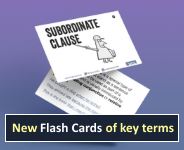Glossary: command
Explanation
A label for the main use (or discourse function) of an imperative clause. For example, Close the door! is an imperative clause which would typically be used to instruct the hearer to do (or not do) something.
Englicious contains many resources for English language in schools, but the vast majority of them require you to register and log in first. For more information, see What is Englicious?

